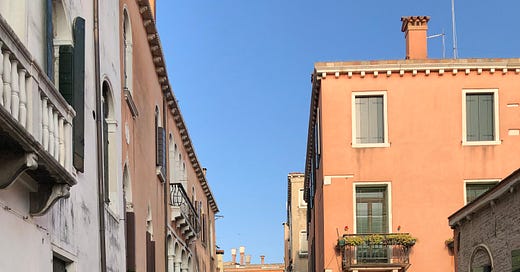Dear friend,
I hope the slow and steady days of September have been kind to you. I find this time of year a little disorienting. In the country where I was raised, September brings the new year. But in the country where I live, September is the beginning of the last few breaths of the year. In my own life, September asks questions I cannot answer: about my brother, who would have had a birthday this month if he was still. About myself, and what I have made of another year. About the days ahead. The days long gone. September hangs between all this like a bridge.
At the Guggenheim Collection in Venice, a sprawling palazzo on the Grand Canal filled with some of the greatest European and North American art of the twentieth century, hangs a nude study by Marcel Duchamp titled Sad Young Man in a Train. It’s supposed to be a self portrait, and you’re supposed to see a young man smoking, the movement of the train through the lines and their shadows. I stood and stood in front of it one morning last November and I saw none of those things. All I saw were shadows and the faint feeling of looking at a bridge at night from far away.
I should clarify that I would have probably understood more if I had accepted the audio guide offered at the entrance. But I prefer my museum visits to be unmediated, especially by the sound of somebody reading (or speaking) explanations for something I would rather observe on my own, getting from it whatever I may and missing the rest.
Some of this is pride, I know. (And that’s also pride, as I’m sure you know). But I think a bigger chunk of it is just self-preservation. If there is a guide, then there is a right and a wrong. And it’s a very short skip from that to turning a wander through a museum - one of my most cherished activities - into a task to be done correctly. So I stood in front of the painting for a long time, while other patrons came to stand briefly beside me, listening to their devices and matching the information to the piece before moving on to the next thing. Then, I went outside to the terrace, overlooking the canal as boats and gondolas lazed by and people took photos of the building on which I stood. I looked out onto the bridge in the distance. I understood then that Venice is also like a bridge, standing on water between the distant past and something else. You stand briefly on its crowded platform and look around, knowing you cannot be there long; you’re there to pass through.
Some time ago, my therapist introduced me to the concept of the five second rule. It was during a time when I was struggling to do many of the things that make up a life, and I was plagued by guilt and shame for not being able to just stop thinking and get on with it. The concept is as simple as it sounds: when you think of something that needs to be done, whether it is washing the dishes or putting your shoes on to go outside, you count to five you and just begin. Take the first step. The five seconds are your bridge between the thought and the action, just long enough to get you started, but not long enough for your brain to help you think out of it. I don’t know why that clicked for me, but it did. Maybe it’s because I have always loved bridges (perhaps you picked up on that). Even on the mornings when it felt impossible to get out of bed, I could will myself to count to five and just let my body’s mechanisms take over from there. One foot, then the next. Desperately bridging myself from here to there.
And so here we are again. Almost at the end of this bridge, entering the still and reflective days leading to the end of the year. With any luck, they will lead us into somewhere good and kind.
Something to eat
One night last week I gently sautéed some minced garlic in my best olive oil, added some salt and coarsely ground black pepper, toasted some rinsed and soaked split lentils, added some dried oregano, covered everything in bone broth and brought it to a boil (I used chicken, 3 parts broth to the lentils). Fifteen minutes and you’ve got a beautiful bowl of soup to enjoy with crusty bread. It’s fast and comforting and (if you haven’t guessed by now) it’s just a small variation on the childhood favorite of pastina in brodo.
Something to read
Geeta has no idea where her husband ran off to, but the people in her village believe she killed him. Her new reputation takes on a life of its own, and soon Geeta is met with women who want her to help them dispose of their husbands, too. The Bandit Queens by Parini Shroff is a darkly hilarious and thrilling ride through the quiet and not-so-quiet rage of women and the men who impose themselves into their lives.
Thank you for being here.




Another absolutely beautiful letter I can relate too — this time of year is always a bit somber and reflective for me, too. I love the metaphor of the bridge and all the ways you seemed to effortlessly connect the “here” with the “there.” I will also now be using the 5-second rule. (The only 5-second rule I knew of was the one when you drop food on the ground. 😆) Thank you, comme toujours, for your words. ✨🤍